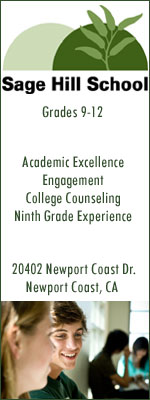|
Featured
Article
Why
Choose an Independent School?
Article By: Patrick F. Bassett,
president, NAIS
Submitted By: Sage
Hill School
Independent
schools are unique.
By
generally agreed upon definition, an independent
school is independent in two critical ways:
-
Independent in governance
(meaning that the schools are organized
as not-for-profit and non-discriminatory corporations
governed by a self-perpetuating board of directors,
as opposed to being "owned" and run by the
government (public schools), by a diocese
(parochial schools) or by for-profit entities
(proprietary schools).
- Independent
in finance (meaning that the schools
charge tuition and raise money to operate
themselves, as opposed to being supported
primarily by public monies or religious subsidies).
It is the independence of independent
schools that offers to them the four essential
freedoms that make independent schools strong:
-
The freedom to define their own mission
(why they exist, whom they serve).
- The
freedom to regulate admissions (admitting
only those students appropriate to the mission).
- The
freedom to define teacher credentials
(hiring, particularly in the middle school
and upper school grades, liberal arts graduates
who have majored in a discipline and who have
a passion about teaching the subject).
- The
freedom to teach what the teachers
decide is important (free from state curricular
and textbook and testing mandates).
It
is important to note that independent schools,
contrary to popular belief and their portrayal
in the media, are not "elitist" in any way except
in terms of academic expectations: The typical
independent school often has more diversity
(racially, ethnically and socio-economically)
than the neighboring public schools (many of
which are quite homogeneous). The socio-economic
diversity of independent schools, for example,
is supported by a significant commitment to
financial aid: Independent school students come
from all family income levels, and approximately
20 percent of them typically are supported by
financial aid.
Although
independent schools continue to attract "legacies"
(i.e., relatives and siblings of graduates and
current students), the largest contingent of
independent school students now comes from erstwhile
public school families, sometimes refugees from
public schools that are failing in one way or
another but increasingly converts from "good
public schools": i.e., those public schools
privileged with an economic base and socio-economic
demographics that make them otherwise comparable
to independent schools.
Independent
school market research has long shown that families
new to independent schools choose our schools
primarily because they perceive the quality
of teaching to be exceptional and the moral
climate to be appropriate. Survey of independent
school parents reveal a remarkably high level
of satisfaction from and support of the parents
in our schools ("total positive" responses counting
only the top two of six possible answers choices:
i.e., strongly agree and agree
or excellent and very good):
- Positive
school spirit is evident.
- The
school has a strong commitment to moral values
and character development.
- The
school supports academic achievement.
- The
school has a caring and community environment.
- Overall
quality of education.
- Likelihood
to recommend the school.
- Likelihood
to continue supporting the school.
- Likelihood
to increase support of the school.
Longitudinal
research confirms the wisdom of choosing an
independent school. As the accompanying chart
illustrates, comparisons of independent school
students with those from "privileged' suburban
public schools reveal the pattern for success
that favor those who attend independent schools.
Roughly speaking, students from independent
schools are about twice as likely (or more)
than their counterparts in "privileged suburban
schools" to...
-
Take algebra I and foreign language in the
eighth grade.
-
Enroll in an A.P. course as a sophomore.
- Study
with a teacher who has graduated from a "Top
100" most selective college.
- Complete
pre-calculus or higher level of mathematics.
-
Play on a junior varsity or varsity sport.
- Participate
in extracurricular arts, academics, and/or
community service.
Sources:
Powell (Lesson from Privilege), Heath (Schools
of Hope), National Center for Educational Statistics
(NCES)
The patterns indicated above begin in our elementary
schools, which place a strong emphasis on creating
a positive learning climate for each child,
and are sustained through our middle and upper
schools, where children are "expected" to do
well academically and "needed" to participate
extracurricularly.
Why are these patterns important? Because they
reflect two critical elements that make independent
school students well prepared for college and
for life:
-
Mastering of a serious academic program.
- Being
a "player."
The
"lessons" of the research are clear. College
admission is dependent on the two factors indicated
above, since what is most important to college
is evidence that a student can undertake a program
of rigorous academic study and indication that
the student can and will contribute to the community
outside of the classroom. What is even more
important to students and parents is the "persistence"
factor: i.e., whereas only about 40 percent
of 25-year-olds have actually completed college,
virtually all independent school graduates not
only attend college but graduate as well. The
ethos of independent schools contributes to
this equation, since "everybody" is expected
to work hard and succeed academically and since
"everybody" is expected be "a player." (The
latter is particularly significant, since the
greatest predictor of success in college and
thereafter is not grades or S.A.T. scores but
involvement in extracurricular life, where the
life skills of "playing fair," "being a team
player," "winning and losing gracefully," "performing
in front of an audience," etc. are developed
and nurtured.) Since independent schools tend
to be small (averaging around 500 students--even
in larger schools, the divisions of lower, middle,
and upper school tend to be around 500 or fewer
students), it is necessary for everyone "to
be a player." The outcome of this necessity
is that even average kids end up being exceptional
contributors, a pattern in independent schools
that translates into success thereafter for
our graduates.
Finally, independent schools are different as
well in terms of the effectiveness of the partnership
between parents and schools: We speak in a unified
voice about a common set of goals and values,
and it is this coalescing of parental and school
voices that points students, like a clarion
bell, towards achievement and guides them towards
decent behaviors and good citizenship.
Author:
Patrick F. Bassett, president, NAIS. An earlier
version of this monograph originally appeared
on the ISACS website (www.isacs.org).
Source: www.nais.org
" Permission: NAIS grants permission to print
this document, without alteration
Submitted By:
Sage Hill School
Newport
Coast, CA
|



![]()
